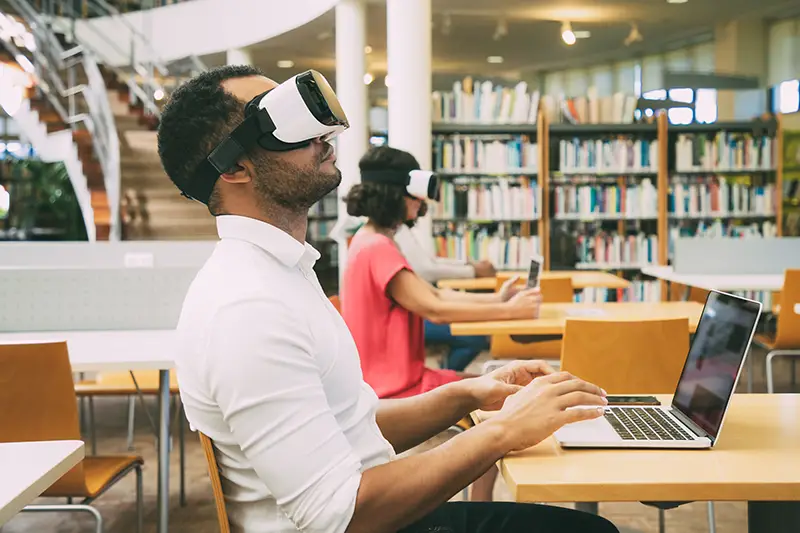Click here to get this post in PDF
Virtual Reality (VR) and Augmented Reality (AR) training have the power to revolutionise small businesses. As we learn to adapt to changing working environments; from an increasingly remote-based workforce to the challenges faced by the long-term impact of Covid-19, having a strong and reliable skills base has never been more important.
VR and AR training is an immersive learning experience that recreates real life settings and simulates work challenges. It gives employees the chance to gain on-the-job training in a risk-free environment where they can learn by doing. Retention of skills learned in VR and AR is high, meaning it is more likely to be applied in the workplace and ultimately lead to increased productivity.
A recent report by PWC found that learners in VR trained 1.5 times faster than e-learners and were 3.75 times more emotionally connected to content than in the classroom. Learners were 275% more confident to apply skills learned after training and four times more focused than their e-learning peers.
On The Job Training
Employees have the chance to experience hands-on, practical and measurable training in a safe, risk-free virtual environment, where skills are learned faster and the retention of learning is improved by the ability to repeat and perfect tasks.
VR specifically offers a collaborative learning environment that accurately replicates a real-world workspace. This means that teams can train together to improve workflows and interdependent tasks. It also can bring together teams in a shared workspace without having to be in the same physical space – great for businesses based over multiple sites or those with significant numbers of remote workers.
AR and VR mix real and digital worlds, immersive technologies and on the job training are a match made in heaven. As immersive experiences often use a human-centred design approach during development, they fit seamlessly with the objectives of on the job training interventions, which are tailored to an individual’s training needs, rather than trying to impose a “one size fits all” approach.
VR and AR training can be fitted around work schedules, rather than making employees spend days away from their workplace on costly training courses. It also means that the learner can access training when it is convenient for them, focus their attention and repeat experiences when necessary. This helps them to learn faster and retain knowledge for longer. What’s more, immersive experiences can also be easily introduced at scale and can respond to changing environments and working practices.
Remote training
Remote collaboration platforms create unique spaces for employees to work and train together. Team members and audiences may be based around the world, but they can connect in one space via a range of devices including VR headsets, PCs and mobile devices. This means that while they may be based remotely, they’re not isolated from each other.
Recruitment & upskilling training
A new company can be uniquely challenging. By creating tailor-made VR and AR onboarding experiences, you can effectively communicate your company’s identity, introduce fellow team members and get a head start on your business operations and procedures; possibly even before their first day on the job.
Ensuring that employees are working at the top of their game and communicating effectively with teammates, customers (and beyond!) is good for business. VR platforms aren’t just great for facilitating collaborative working for remote workers but can be harnessed as a powerful learning and development tool. By using immersive technologies, tailored training programmes in AR and VR allow team members to learn quicker and deeper, leading to increased retention rates and productivity, as well as provide tangible cost savings.
High risk training
VR-based training has the power to connect remote teams to learn together in a safe and inclusive environment. By taking training out of the real world and replicating real-life, high risk scenarios in a virtual space, employees have the chance to learn by doing in real time, in ways that will often be impossible or dangerous to do in real life. This has significant benefits for teams working in highly skilled and specialised areas; especially where team members’ actions are interdependent on each other.
Soft skills
For training that focuses on soft skills, interaction with, and reaction to, another person is central to the learning process. The increasing sophistication of VR platforms to pick up on, and react to certain behaviours, means that immersive courses are incredibly effective for the development of skills such as problem solving, communication and emotional intelligence. So, whether it’s honing presentation skills or improving customer relationships, through to learning how to work in an inclusive environment and team building, training no longer requires face-to-face scenarios or classroom-based learning.
Why Agile Training is Crucial for Every Software Development Team
Is the future of training virtual?
Adopting innovative new training programmes is a crucial part of a company’s need to evolve in response to our changing world, in addition to the fragmentation of workplaces through globalisation and remote working. The recent advances in VR and AR means that training can offer a perfect solution to keep your employees highly trained, motivated and productive – just at the time when you need them performing at their best.
Author – Tim Fleming, CEO, Future Visual
Tim is CEO and co-founder of Future Visual who are experts in producing award winning VR and AR content on their collaboration platform VISIONxR™. Clients and partners including ESL One, IATA, Peugeot and John Lewis.


